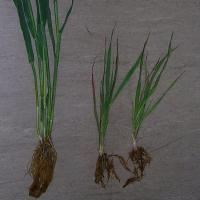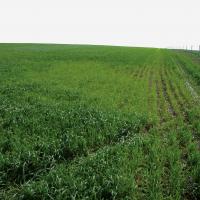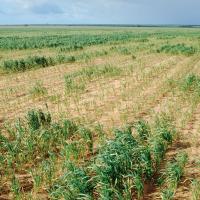Diagnosing cereal cyst nematode
A soil-borne pest affecting roots of cereal crops, cereal cyst nematode (CCN) can cause substantial yield losses, particularly in continuous cereal crops.
What to look for
- Poor emergence and establishment.
- Pale green patches of unthrifty plants in young crops (particularly on sandy, less fertile soils).
- Plants wilt despite moist soil.
Paddock
- Affected plants are stunted with few tillers.
- Roots are thickened, shortened and distinctly ‘knotted’ with lots of small laterals.
- In spring, white pinhead-sized nematode cysts are visible on roots when soil is carefully wash off.
- Cysts turn brown at the end of the season.
Plant
What else could it be
| Condition | Similarities | Differences |
|---|---|---|
| Diagnosing root lesion nematode in cereals | Stunted plants with brown roots | Root lesion nematodes do not cause the distinctive knotted roots |
|
Nutrient deficienct
|
Small plants | Nutrient deficient plants do not have knotted roots |
Where did it come from?

Continuous wheat
- Continuous cereal cropping and wheat after grassy pastures can contribute to nematode infections.
Management strategies

Rotation

Resistant varieties

Grass weed control
- Since many cereal varieties grown in WA are susceptible to CCN it may be necessary to halt cereal production in favour of a non-host crop (canola, lupin) to reduce CCN numbers in the soil.
- Severe infestations might require more than one non-host crop to lower CCN below yield-limiting levels.
- Some barley and wheat varieties are resistant to CCN.
- Control volunteer grasses and cereals — especially wild oats.
- Cultivation is not an effective control measure as it spreads the nematodes around the paddock making the problem worse.
How can it be monitored?

Soil test
- Growers can use PreDicta B (a DNA-based soil testing service) to identify the risk of CCN, take-all, rhizoctonia root rot, crown rot and root lesion nematode (Pratylenchus neglectus and P. thornei) to broadacre crops before seeding.
- Affected plants in paddocks expressing suspected CCN symptoms should be sample and submitted for testing through AGWEST Plant Labs. CCN build up, while relatively uncommon, can be very damaging.
See also
Further information
Where to go for expert help
Page last updated: Tuesday, 25 July 2017 - 8:46am





